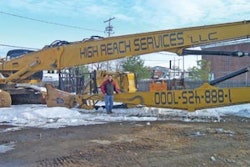
I was originally planning on sharing tips on bonus plans but tripped across a topic that doesn't appear to get much attention: operations manuals.
You see, I was giving a two-hour workshop on communication for a contractor and was second on the agenda. I arrived early to meet the attendees, and watch how they interacted.
The first presentation was a page-by-page walk-through of the company's operations manual. As the company runs projects in 21 states for a very picky clients, consistency of performance is mandatory and their ops manual is the tool to assure consistency.
It was amazingly well put together. It hit on everything a project manager or site superintendent needed to know in order to bring their jobs in on time and in budget. The manual had the side benefit of not being overbearing or a burden.
Truth be told, this was an EXTREMELY well organized contractor.
Operations manuals are THE place to document the systems you need running smoothly in order to grow your business. You will probably need two versions: one manual for your project managers and office staff and one for your field leaders.
Your field leaders' manual will be smaller, more concise. You need to adjust the amount of information in the field leaders' manual based on the decision making authority you grant them. Your business should be running on forms, check sheets, examples, and flow charts. These are the tools of systemization. Your manual should be loaded with them.
Forms
Project management runs on paperwork. Gone are the days that you can SAFELY run your business on handshakes and phone calls. Forms are required.
Your manual should contain three versions of each form: blank paper, completed sample, and electronic. Some foremen and superintendents, generally those born before 1977, will prefer paper. Others will feel paper is stupid and want to use a computer. Make your procedures flexible enough to accommodate both.
Here is the minimum list of forms that should be in your manual:
- Time Sheets
- Daily Log
- Change Orders / Work Requests
- Requests For Information
- Lien Releases
- Production Reporting Sheets
- Employment Applications
- Accident Report
- Equipment Maintenance & Repair
- Take-off Sheets
- Vacation Notifications / Requests
- Performance Review
- Interview Summary
- Job Description
- Crew Activity Plan
- Action Plan
- Project Summary (who, what, where, deadline, goals)
Quality Standards
Your manual must clearly present the minimum
craftsmanship required by your company. Present two
sets of standards:PREFERRED and ACCEPTABLE.
PREFERRED is the goal. It is the performance you're looking for. ACCEPTABLE is the quality level at which the crew should not rip it out and do it over. This is very important to get across. You can't afford to rip out work that is acceptable to the client.
The best way to communicate quality standards is through a combination of pictures, procedures, and check lists.
PICTURES
We are taking a trick from the auto industry, made
famous by Toyota. Nothing communicates quality
standards better than pictures. Use editing software
to add comments pointing out important details. Pictures
also work well for communicating a procedure.
Most construction workers can "see" things. Present information to them in a visual format as much as possible.
PROCEDURES
Document important work procedures. Use either a written
sequence (okay), a flow chart (better), or numbered
pictures with text (best). Hit the important steps and
key decisions.
CHECK LISTS
The easiest way to get started. Turn critical check
lists into forms that contain a place for the employee
to initial upon completion.
Purchase Policies
Establish a spending limit for each position. Explain
where tools and equipment are usually purchased.
Provide a list of suppliers from whom materials may be
ordered. Indicate when material should be pulled from
inventory and when it should be bought from a supplier.
Describe the paper work required for purchasing and / or receiving tools and material.
Safety
In this day and age, keeping people safe is not only a
moral obligation, it makes financial sense.
Weekly meetings are required onsite. Provide safety
talks in the operations manual. Show the procedure for
reporting an accident. Clarify the need to report even
the most minor reportable.
Staffing
This section should start with a copy of all job
descriptions. All employees need to know who does what
in your company. That awareness alone saves lots of
hassle and lost time.
For recruiting and staffing; include a list of all resources used to advertise openings, sample help wanted advertisements for use online and in print, bonus program for new employee referrals, and pay scales for field positions.
You also need to present a summary of the EEOC guidelines to ensure no one steps outside the lines when writing help wanted ads and during the interview process.
Provide detailed interviewing instructions including a flow chart showing the process, sample interview questions, an agenda for running interviews, a list of people involved and their roles, and any tests or surveys to be used.
Personnel Management
Clearly explain the following policies and procedures:
- Anti-harassment
- Disciplinary
- Performance review
- Attendance
Project Management Procedures
Your firm must perform several project management tasks
well in order to be profitable. You operations manual
is the perfect place to capture the means and methods
of performing them.
Explain the following procedures:
- Estimating
- Scheduling
- Job Costing
- Close-out
- Accounting
Easy, Right?
Sure, your manual is going to be a monster but it will
be invaluable to your company's growth. Think of it as
the history of your company's development.
For that matter, you can really bring your manual to life by starting it off with a message from the founder, an explanation of how it got to where it is, and the legacy you hope to leave.
More than anything, your operations manual is your library of best practices. That is a term that has faded away to some extent but it is a great term and a great goal: constantly be improving and documenting the best practices used in your business. Your business' performance and value will escalate as you do.
If you would like assistance with the creation of your operations manuals or find yourself far short of having the described procedures and systems perfected, give me a call (913-961-1790)




















